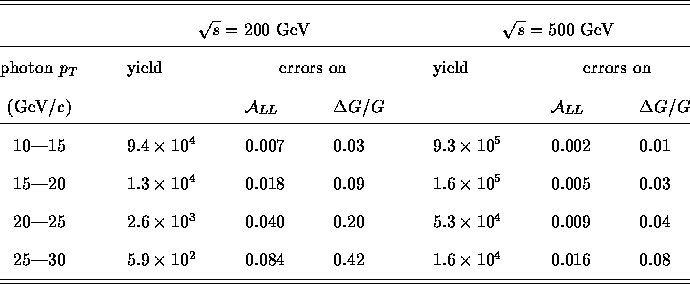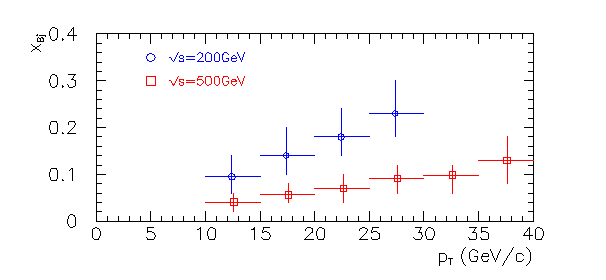


Next: Measurements of Anti-quark
Up: Measurements of Spin
Previous: General Approach to
As mentioned above, the experiment E704 at FNAL has measured
the  for multi-photon production in polarized pp collisions
at
for multi-photon production in polarized pp collisions
at  GeV [5].
The multi-photons are presumably originated in
the electromagnetic part of the jet energy. Since jet-production
is highly dominated by the gluon-gluon scattering and gluon-quark
scattering, the asymmetry is
quite sensitive to the gluon polarization. The measured asymmetries have
been compared with the model predictions. This is one of the constraints
currently available.
GeV [5].
The multi-photons are presumably originated in
the electromagnetic part of the jet energy. Since jet-production
is highly dominated by the gluon-gluon scattering and gluon-quark
scattering, the asymmetry is
quite sensitive to the gluon polarization. The measured asymmetries have
been compared with the model predictions. This is one of the constraints
currently available.
Several groups have analyzed experimental data on asymmetry
to extract gluon polarization. For example, Ball, Forte, Ridolfi performed
next-to-leading order (NLO) analysis of the experimental data and
concluded that most probable size of the gluon polarization is
around [13]

One of the most reliable channels to measure the gluon polarization
is high  prompt photon production. The production cross section
measured at CERN and FNAL has been used to extract gluon
distribution
prompt photon production. The production cross section
measured at CERN and FNAL has been used to extract gluon
distribution .
.
The production in pp collision is dominated by the gluon
Compton process followed by annihilation process.
Our Monte Carlo simulation study
by PYTHIA [14]
shows about 90% of the production originates in the gluon Compton
process.
If the polarization of the anti-quark is small, actually this can be
checked in
weak boson production, the contribution of annihilation process to
the asymmetry
can be negligible, and the asymmetry can be written at the leading
order (LO) as

Since partonic level asymmetry  is
calculated in QCD, and quark polarization
is
calculated in QCD, and quark polarization  has been
measured in pol-DIS experiments, thus gluon polarization
has been
measured in pol-DIS experiments, thus gluon polarization  can be extracted from the experimentally measured asymmetry,
can be extracted from the experimentally measured asymmetry,  .
.
For the complete reconstruction of the partonic level kinematics,
the detection of the quark jet is desirable. The STAR detector system
is advantageous in the jet detection due to its hermetic coverage.
The jet finding efficiency with STAR detector in pp collision
at  GeV is about 50-85% depending on the
GeV is about 50-85% depending on the  of
jet with the
of
jet with the  resolution of
resolution of  30% [15].
In the PHENIX detector system, the reconstruction of the quark jet
momentum is very difficult. The momentum fraction carried by
initial gluon, however, can be estimated with
full-fledged Monte Carlo simulation
like PYTHIA and plotted as a function of photon
30% [15].
In the PHENIX detector system, the reconstruction of the quark jet
momentum is very difficult. The momentum fraction carried by
initial gluon, however, can be estimated with
full-fledged Monte Carlo simulation
like PYTHIA and plotted as a function of photon  in Figure 4.
in Figure 4.
The yield has been calculated using
PYTHIA utilizing parton distribution set
GRV94LO [16] and listed in Table iv
for both  200 GeV and 500 GeV.
In addition, the sensitivity of the
gluon polarization measurement has been evaluated assuming the
product of
200 GeV and 500 GeV.
In addition, the sensitivity of the
gluon polarization measurement has been evaluated assuming the
product of  .
The results are
summarized in Table iv.
.
The results are
summarized in Table iv.

Table iv: Sensitivity summary for the measurements of gluon polarization
via prompt  production.
production.
The main difficulty in the detection of the prompt photon in pp collision is
the huge background from  .
Basically invariant mass of two photons should be useful to identify the
origin, but not perfect.
In the low
.
Basically invariant mass of two photons should be useful to identify the
origin, but not perfect.
In the low  region, the fake photon due to one photon missing
the detector is dominant.
In the higher
region, the fake photon due to one photon missing
the detector is dominant.
In the higher  region, two photons from neutral meson tend to
merge into one cluster within a finite resolution of the detector and fake
single photon.
Even a severe background from radiative decay of the mesons is expected to
to be reducible significantly by requiring isolation of the photon
from other particles.
Indeed, the simulation studies using PYTHIA shows that the detection of
prompt photon will be feasible in the
region, two photons from neutral meson tend to
merge into one cluster within a finite resolution of the detector and fake
single photon.
Even a severe background from radiative decay of the mesons is expected to
to be reducible significantly by requiring isolation of the photon
from other particles.
Indeed, the simulation studies using PYTHIA shows that the detection of
prompt photon will be feasible in the  region, 10
region, 10 30 GeV/c.
30 GeV/c.

Figure 4: Correlation between Bjorken-x and transverse momentum of
photon.
For further test of the measurement of
gluon polarization, we are investigating the
asymmetry for open heavy quark and
heavy quarkonium productions. Especially recent
studies show that dimuon production in pp collision at  GeV
is dominated by coincidental semi-leptonic decay of D-mesons. Since
the production of charm quark in pp collision
is dominated by gg scattering, the asymmetry
GeV
is dominated by coincidental semi-leptonic decay of D-mesons. Since
the production of charm quark in pp collision
is dominated by gg scattering, the asymmetry
 for the production
is sensitive to polarized gluon density.
The next-to-leading order calculation of the
asymmetry is partially done [17,18].
In addition, charmonium production has been
quoted to be very sensitive to the polarized
gluon density for long time basing on
LO calculations [19,20,21].
Recent CDF data have, however, shown that LO calculation of
the cross section significantly underestimates experimentally measured
cross sections [22].
It seems that any model on the production has failed to
reproduce the every aspects of the production, such as rapidity distribution,
for the production
is sensitive to polarized gluon density.
The next-to-leading order calculation of the
asymmetry is partially done [17,18].
In addition, charmonium production has been
quoted to be very sensitive to the polarized
gluon density for long time basing on
LO calculations [19,20,21].
Recent CDF data have, however, shown that LO calculation of
the cross section significantly underestimates experimentally measured
cross sections [22].
It seems that any model on the production has failed to
reproduce the every aspects of the production, such as rapidity distribution,
 distribution, and polarization of the charmonia. Since various higher
mass states contribute to
distribution, and polarization of the charmonia. Since various higher
mass states contribute to  production, measurement of the asymmetry
for
production, measurement of the asymmetry
for  production has been proposed and the study
is underway [23].
production has been proposed and the study
is underway [23].



Next: Measurements of Anti-quark
Up: Measurements of Spin
Previous: General Approach to
Saito Naohito
1997年01月28日 16時48分17秒
 for multi-photon production in polarized pp collisions
at
for multi-photon production in polarized pp collisions
at  GeV [5].
The multi-photons are presumably originated in
the electromagnetic part of the jet energy. Since jet-production
is highly dominated by the gluon-gluon scattering and gluon-quark
scattering, the asymmetry is
quite sensitive to the gluon polarization. The measured asymmetries have
been compared with the model predictions. This is one of the constraints
currently available.
GeV [5].
The multi-photons are presumably originated in
the electromagnetic part of the jet energy. Since jet-production
is highly dominated by the gluon-gluon scattering and gluon-quark
scattering, the asymmetry is
quite sensitive to the gluon polarization. The measured asymmetries have
been compared with the model predictions. This is one of the constraints
currently available.




 prompt photon production. The production cross section
measured at CERN and FNAL has been used to extract gluon
distribution
prompt photon production. The production cross section
measured at CERN and FNAL has been used to extract gluon
distribution

 is
calculated in QCD, and quark polarization
is
calculated in QCD, and quark polarization  has been
measured in pol-DIS experiments, thus gluon polarization
has been
measured in pol-DIS experiments, thus gluon polarization  can be extracted from the experimentally measured asymmetry,
can be extracted from the experimentally measured asymmetry,  .
.
 GeV is about 50-85% depending on the
GeV is about 50-85% depending on the  of
jet with the
of
jet with the  resolution of
resolution of  30% [
30% [ in Figure
in Figure  200 GeV and 500 GeV.
In addition, the sensitivity of the
gluon polarization measurement has been evaluated assuming the
product of
200 GeV and 500 GeV.
In addition, the sensitivity of the
gluon polarization measurement has been evaluated assuming the
product of  .
The results are
summarized in Table
.
The results are
summarized in Table 
 production.
production. .
Basically invariant mass of two photons should be useful to identify the
origin, but not perfect.
In the low
.
Basically invariant mass of two photons should be useful to identify the
origin, but not perfect.
In the low  region, the fake photon due to one photon missing
the detector is dominant.
In the higher
region, the fake photon due to one photon missing
the detector is dominant.
In the higher  region, two photons from neutral meson tend to
merge into one cluster within a finite resolution of the detector and fake
single photon.
Even a severe background from radiative decay of the mesons is expected to
to be reducible significantly by requiring isolation of the photon
from other particles.
Indeed, the simulation studies using PYTHIA shows that the detection of
prompt photon will be feasible in the
region, two photons from neutral meson tend to
merge into one cluster within a finite resolution of the detector and fake
single photon.
Even a severe background from radiative decay of the mesons is expected to
to be reducible significantly by requiring isolation of the photon
from other particles.
Indeed, the simulation studies using PYTHIA shows that the detection of
prompt photon will be feasible in the  region, 10
region, 10 30 GeV/c.
30 GeV/c.

 GeV
is dominated by coincidental semi-leptonic decay of D-mesons. Since
the production of charm quark in pp collision
is dominated by gg scattering, the asymmetry
GeV
is dominated by coincidental semi-leptonic decay of D-mesons. Since
the production of charm quark in pp collision
is dominated by gg scattering, the asymmetry
 for the production
is sensitive to polarized gluon density.
The next-to-leading order calculation of the
asymmetry is partially done [
for the production
is sensitive to polarized gluon density.
The next-to-leading order calculation of the
asymmetry is partially done [ distribution, and polarization of the charmonia. Since various higher
mass states contribute to
distribution, and polarization of the charmonia. Since various higher
mass states contribute to  production, measurement of the asymmetry
for
production, measurement of the asymmetry
for  production has been proposed and the study
is underway [
production has been proposed and the study
is underway [